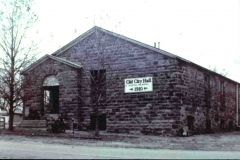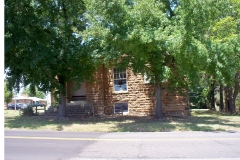| Address: | State Highway 75 and Seminole, Weleetha, Oklahoma | County: | Okfuskee |
| Started: | Completed: | 1940 | |
| Agencies: | WPA | NHRP: | March 25, 1993 |
Current Usage:
Museum
Description:
Summary
The Weleetka Town Hall and Jail, built in 1910 and modified in 1940, is a onestory, sandstone building designed in a vernacular expression of the Romanesque Revival style. The focal-point of the gabled-roofed building is an offset, gabled entry portal with an arched entry composed of stone voussoirs. The building is located on the edge of downtown Weleetka, composed of older onestory commercial buildings most of which have been altered with the addition of shingled, faux-mansard roofs. The sandstone First National Bank, built in 1902, is visible from the grounds of the town hall. The Weleetka Town Hall and Jail retains the historical integrity of its 1940 appearance.
Historical Description
The Weleetka Town Hall and Jail was originally built in 1910, according to the design of A. C. Davis. Constructed by the firm of Hubbard and Duggan, contractors, the building was a two-story building designed a vernacular expression of the Romanesque Revival style. It was constructed of coursed, quarry-faced sandstone, obtained from a local quarry. The building measured 80 x 40 feet and was sheltered by a gabled roof, pierced by at least four slope chimneys. Characteristic of the style, the focal point of the building was a three-story, corner entry tower with a hipped roof, crowned by a finial. Entry was provided on two sides of the tower through a round-arched opening composed of voussoirs, graced by a fanlight. The fenestration consisted of 8/2, singlehung sashes set in rectangular openings, with sandstone lug sills. The tower’s third story featured narrow, paired windows. A rear entrance at the northwest corner was composed of a pair of wooden, glazed, paneled double-doors with a 12-light transom. By 1940, neglect had rendered the second story of the Town Hall and Jail unsound. The city therefore engaged the services of Hugh W. Brown to redesign the building and remove the second floor; at the same time an addition was made to the north end of the building. The Town Hall and Jail appears today much as it did when work was completed in 1940.
Present Description
The one-story, sandstone building is covered by a gabled roof. When the building was redesigned, the corner tower’s second and third stories were removed and the remaining portion was refashioned into a one-story entry portal with a lower, gabled roof. The arched entries were retained, but the fanlights and original entry doors no longer remain. The original window 8/2 sashes remain in some of the windows at the west elevation, but on the east elevation some of the lower sashes have been replaced with a single pane, windows retain their sandstone lug sills. All of the When the building was remodeled, the northwest end of the building was altered to accommodate the fire department. An area that had served as a court room and offices was redesigned to hold fire trucks, the entry at the northwest corner was moved, and a new, wide opening was created to hold a pair of wooden overhead doors. The northwest corner opening contains a pair of wooden, glazed, paneled doors, but no transom. To the north is a one-story, sandstone addition, shorter than the rest of the building. The 20 x 25 foot addition was built to house the police station and jail cells. It has a central entry containing a slab door, flanked by a 5/2 window on the north. Additionally, four small fixed windows pierce the facade. A nonoriginal, aluminum canopy shelters the entry. The interior features 10-foot-tall ceilings clad with pressed metal. The building retains integrity of its 1940 appearance in terms of location design, setting, materials, workmanship, feeling, and association.
Summary
The Weleetka Town Hall and Jail is significant under Criterion A for its strong association with the history of municipal government in Weleetka. From 1910 until 1957, the building served as the headquarters for municipal government in Weleetka. The building was built in 1910 by Hubbard and Duggan, contractors, according to the design of A. C. Davis, architect. In 1940, it was redesigned by Hugh W. Brown, architect, and assumed its current appearance.
Significance
The Weleetka Town Hall and Jail is significant as the center of municipal government during the early years of the history of Weleetka, Oklahoma. Weleetka was founded in 1902 in what was then the Creek Nation, Indian Territory, on land owned by Creek farmers. White speculators struck an agreement with the Creek landowners to obtain townsite occupancy rights, as whites could not own land legally within the Creek Nation. The speculators were newspapermen George Clarke and O. W. Meacham, manager and printer, respectively, for the Vinita Leader, a newspaper published in the northeastern Oklahoma town of Vinita, and Lake Moore, publisher of the newspaper at Fairland, Oklahoma who sought to take advantage of their advance knowledge of the planned route of the Fort Smith and Western Railroad. Town lots were sold at auction on February 10, 1902, and the following day the First Bank of Weleetka opened for business. Soon a second bank, which became the First National Bank, also opened; that building, along with the Weleetka Town Hall and Jail, is one of the few extant reminders of the early days of Weleetka. The town was located adjacent to the fertile bottomlands of the North Canadian River, and so it became a trade center for the surrounding cotton farms. By 1910, the town had grown considerably, making necessary the construction of the Weleetka Town Hall and Jail to house the town’s various municipal and utility offices. The town had become home to more than 3,000 people, two railroads, three cotton gins, a cotton press, and many businesses. The Weleetka Town Hall and Jail was designed in a vernacular Romanesque Revival style, constructed of sandstone from a local quarry. When completed, the Town Hall and Jail became the town’s principal public building and the focus of municipal government. The building housed the town clerk’s office, where citizens went to transact municipal business, and a meeting room for the Town Trustees. In addition, the basement held the town jail, and the rear of the building housed a small courtroom and chambers for the circuit judge and the justice of the peace. The electric and water companies rented offices in the Town Hall, as well.
The 1920s and 1930s were decades of economic hardship for Weleetka, as agricultural depression, drought, and floods took their toll. Poor economic times meant little money for upkeep of the Town Hall, and by 1940 the second story had become unsound due to neglect. To save the building, the Town Trustees engaged the services of Hugh W. Brown to redesign the building and remove the second floor. In refashioning the building, Brown proved sensitive to the original 1910 design. He retained the arched, Romanesque Revival entry portal, the quarryfaced sandstone walls, and the windows, with their sandstone lintels and sills. In accommodating a new use by the fire department, he endeavored to affect the visual appearance of the exterior as little as possible. And in designing the addition to the rear, he utilized quarry-faced sandstone walls to echo the appearance of the original, but kept it distinctive by making it slightly shorter that the historic building. In a period when many towns began replacing their historic buildings with new construction, Weleetka’s decisionmakers responded to the challenge of structural problems and changing needs by reshaping the building, yet retaining much of its historic character. With the new design, the building continued to function as the center of municipal government until 1957. The town clerk and the Trustees remained in the building. New tenants included the police department and the fire department, which took over the portion of the building formerly occupied by the circuit court. In 1957, the offices of the town clerk were moved to another building. The fire and police departments, however, continued to be housed in the building until 1991. Historically the Weleetka Town Hall and Jail served as the town’s principal public building and the center of official government business and thereby touched the lives of each citizen. Today it stands as an important reminder of the town’s first half-century.
Bibliography
Blackman, T. W. “Interesting Article Dealing with Events and Persons of the Early Day Western Town.” Unpublished manuscript, n.d.
Hitchcock, E. A., Secretary of the Interior. Letter to the Commission to the Five Civilized Tribes, February 8, 1904.
Weleetka. Weleetka Town Hall, Town Clerk’s Office. Deed records.
Weleetka. Weleetka Town Hall, Town Clerk’s Office. Minutes of the Town Trustees. 1910, 1940, 1957.
Weleetka, “Running Water.” Indian Territory (promotional pamphlet). [ca. 1905.





Recent Comments